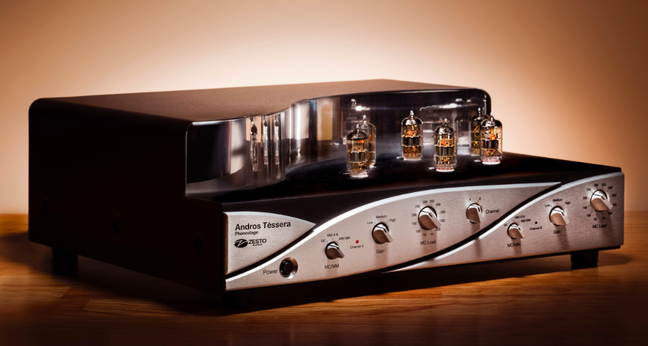Mr Spock
demokratischer - sektor
- Μηνύματα
- 19.090
- Reaction score
- 53.848

The Greek word tessera refers to the number four. Zesto Audio uses that definition (tessera; τέσσερα) to name its latest phonostage. The word is fitting in function since the Andros Téssera phonostage supports four inputs. The word téssera is also defined as an individual tile in a mosaic. What the reader will find out is the “individual tile in a mosaic” is correspondingly applicable to this component since the Andros Téssera also serves as a tile in the mosaic of analog music reproduction.
On the front panel of the Andros Téssera, the first group of rotary switches within a middle faceplate—identified as “Channel A”—are mc/mm, gain, loading, and channel (bank) controls. Within that “Channel A” group, the mc/mm rotary switch allows mc/mm 47k/mm 68k selections for the two inputs—moving coil or moving magnet (47k or 68k loading for that mm input; mm capacitance is fixed at 220pF). The gain switch allows control of the gain level of low (60dB mc, 40dB mm), medium (65dB mc, 45dB mm), and high (70dB mc, 50dB mm). The loading switch has twelve positions for selecting mc load values of between 50 ohms and 1000 ohms that can be switched on the fly during listening to make selection choice more convenient. These 12 mc load values are electrically located on the secondary side of the step-up transformer in order to allow the cartridge to deliver the full signal to the primary-side of the transformer. The final rotary switch in the group selects the bank inputs for “Channel A” (the selections just described) or “Channel B” (the rotary switch selections in the curved faceplate overlay on the right side of the front panel). An LED will illuminate on the front panel identifying which channel is active. The three remaining switches are duplicates of the mc/mm, gain, and loading for the separate “Channel B” inputs. They have the same function described above but are for the second bank of inputs on “Channel B.”
Specs
Type: Tube phonostage
Tube complement: 4x ECC83s (12AX7s), 2x ECC82s (12AU7s)
Gain (moving-coil): 60dB, 65dB, 70dB
Gain (moving-magnet): 40dB, 45dB, 50dB
Cartridge loading (moving-coil): 50, 100, 150, 200, 250, 300, 350, 400, 500, 700, 800, 1000 ohms
Cartridge loading (moving-magnet): 47k, 68k ohms
Output impedance: 150 ohms
Dimensions: 17" x 5.5" x 14" (main chassis); 17" x 5" x 8" (power supply)
Weight: 25 lbs. (main chassis); 17 lbs. (power supply)
In the end, the Zesto Audio Andros Téssera phonostage embodied a certain level of surefooted calmness. Easy to operate in daily use, it appeared to be a quiet and solidly designed piece of electronics. It didn’t seem to give any more than it took from the cartridge by adding something obtrusive to the signal. It was warm and full-bodied in a preferred way, but there was nothing thick or sluggish about it—the sound retained timing and pacing along with its portrayal of musical content. With the capability to connect up to four tonearm/cartridge combinations, the user has the option to quadruple his analog front-end input choices for musical playback from a single phonostage. A look and listen are encouraged.
